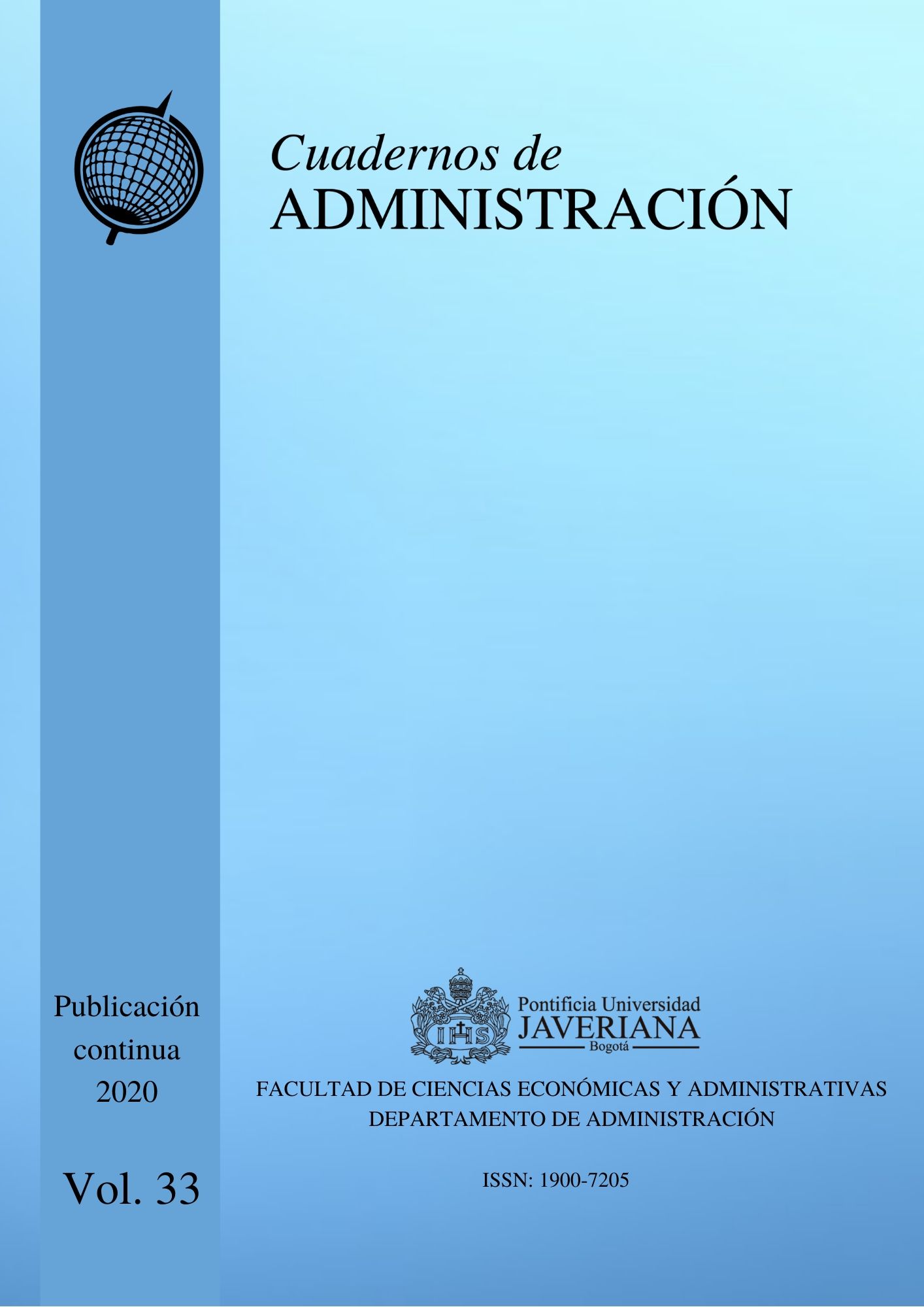Resumen
Esta investigación desarrolla una propuesta inicial de un Sistema de Apoyo a la toma de decisiones –DSS, siglas en inglés– para la planificación y distribución en la agricultura de nuevos productos perecederos. Este sistema está basado en un enfoque jerárquico, que puede ser implementado en las empresas como un módulo planificado o como un sistema independiente para planificar la producción de la cosecha. En este artículo se resalta la importancia del DSS para las pequeñas y medianas empresas, o para grupos de pequeños cultivadores que necesitan mejorar la coordinación entre sus cultivos y sus decisiones de mercado. El DSS cubre las decisiones estratégicas, tácticas y operacionales para cada estación, centrándose en la introducción de nuevos productos. El objetivo del DSS es incrementar la competitividad de los agricultores en un mercado altamente variable y complejo. El sector agrícola aún necesita evolucionar para satisfacer las demandas crecientes, entender los gustos particulares de los nuevos consumidores y evaluar los requerimientos de los nuevos actores.
Ahumada, O., & Villalobos, J. R. (2009). Application of planning models in the agri-food supply chain: A review. European Journal of Operational Research, 196(1), 1-20. https://doi.org/10.1016/j.ejor.2008.02.014
Ahumada, O., & Villalobos, J. R. (2011). A tactical model for planning the production and distribution of fresh produce. Annals of Operations Research, 190(1), 339-358. https://doi.org/10.1007/s10479-009-0614-4
Ahumada, O., Villalobos, J. R., & Mason, A. N. (2012). Tactical planning of the production and distribution of fresh agricultural products under uncertainty. Agricultural Systems, 112, 17-26. https://doi.org/10.1016/j.agsy.2012.
Alexandratos, N., & Bruinsma, J. (2012). World agriculture towards 2030/2050: The 2012 revision. ESA Working Papers 12-03. Food and Agriculture Organization of the United Nations. https://doi.org/10.22004/ag.econ.288998
Allaoui, H., Guo, Y., Choudhary, A., & Bloemhof, J. (2018). Sustainable agro-food supply chain design using two-stage hybrid multi-objective decision-making approach. Computers & Operations Research, 89, 369-384. https://doi.org/10.1016/J.COR.2016.10.012
Banasik, A., Bloemhof-Ruwaard, J. M., Kanellopoulos, A., Claassen, G. D. H., & van der Vorst, J. G. A. (2018). Multi-criteria decision making approaches for green supply chains: A review. Flexible Services and Manufacturing Journal, 30(3), 366-396. https://doi.org/10.1007/s10696-016-9263-5
Burstein, F., & Holsapple, C. W. (2008). Handbook on decision support systems 2: Variations. Springer Science & Business Media.
Dantzig, G. B. (2010). Linear programming under uncertainty. In Stochastic programming (pp. 1-11). Springer.
Farahani, P., Grunow, M., & Günther, H.-O. (2012). Integrated production and distribution planning for perishable food products. Flexible Services and Manufacturing Journal, 24(1), 28-51.
Flores, H., Villalobos, J. R., Ahumada, O., Uchanski, M., Meneses, C., & Sanchez, O. (2019). Use of supply chain planning tools for efficiently placing small farmers into high-value, vegetable markets. Computers and Electronics in Agriculture, 157, 205-217.
Glen, J. J. (1987). Mathematical models in farm planning: A survey. Operations Research, 35(5), 641-666.
Grunert, K. G., Jensen, B. B., Sonne, A.-M., Brunsø, K., Byrne, D. V, Clausen, C. (2008). User-oriented innovation in the food sector: Relevant streams of research and an agenda for future work. Trends in Food Science & Technology, 19(11), 590-602.
Kader, A. A. (2002). Postharvest technology of horticultural crops (Vol. 3311). University of California Agriculture and Natural Resources.
Kamble, S. S., Gunasekaran, A., & Gawankar, S. A. (2020). Achieving sustainable performance in a data-driven agriculture supply chain: A review for research and applications. International Journal of Production Economics, 219, 179-194. https://doi.org/10.1016/J.IJPE.2019.05.022
Kaufman, P. R. (2000). Understanding the dynamics of produce markets consumption and consolidation grow. London: Diane Publishing.
Linnemann, A., Hendrix, E., Apaiah, R., & van Boekel, T. (2015). Food chain design using multi criteria decision making, an approach to complex design issues. NJAS-Wageningen Journal of Life Sciences, 72-73, 13-21. http://dx.doi.org/10.1016/j.njas.2014.10.002
Little, C., Aqueveque, C., & Aguilera, J. M. (2015). Producer–consumer misalignment as a possible cause for new food failure: empirical evidence from Chile. Journal of international food & agribusiness marketing, 27(3), 228-253. https://doi.org/10.1080/08974438.2014.940120
Lowe, T. & Preckel, P. (2004). Decision technologies for agribusiness problems: A brief review of selected literature and a call for research. Manufacturing & Service Operations Management, 6(3), 201-208. https://doi.org/10.1287/msom.1040.0051
Moskowitz, H. R., Saguy, I. S., & Straus, T. (2009). An integrated approach to new food product development. London: CRC Press.
Perosio, D., McLaughlin, E., Cuellar, S., & Park, K. (2001). Supply chain management in the produce industry. New York: Cornell University. https://doi.org/10.22004/ag.econ.122645
Rae, A. N. (1971). An empirical application and evaluation of discrete stochastic programming in farm management. American Journal of Agricultural Economics, 53(4), 625-638. https://doi.org/10.2307/1237827
Rae, A. N. (1977). Crop management economics. London: Crosby Lockwood Staples. 525 p.
Rezaeian, J., Haghayegh, S., & Mahdavi, I. (2016). Designing an integrated production/distribution and inventory planning model of fixed-life perishable products. Journal of Optimization in Industrial Engineering, 9(19), 47-60. https://doi.org/10.22094/JOIE.2016.229
Sagarpa. (2010). Retos y oportunidades del sistema agroalimentario de México en los próximos 20 años. Working Paper, s.n. http://www.sagarpa.gob.mx/agronegocios/Documents/pablo/retosyoportunidades.pdf
Vidal, C. J., & Goetschalckx, M. (2001). A global supply chain model with transfer pricing and transportation cost allocation. European Journal of Operational Research, 129(1), 134-158. https://doi.org/10.1016/S0377-2217(99)00431-2
Villalobos, J. R., Soto-Silva, W. E., González-Araya, M. C., & González–Ramirez, R. G. (2019). Research directions in technology development to support real-time decisions of fresh produce logistics: A review and research agenda. Computers and Electronics in Agriculture, 167, 105092. https://doi.org/10.1016/J.COMPAG.2019.105092
Zuurbier, P. J. (1999). Supply chain management in the fresh produce industry: A mile to go? Journal of Food Distribution Research, 30(856-2016–57418), 20-30. https://doi.org/ 10.22004/ag.econ.26781

Esta obra está bajo una licencia internacional Creative Commons Atribución 4.0.
Derechos de autor 2020 Omar Ahumada Valenzuela, Jesus Rene Villalobos, Juan Carlos Leyva López, Jesús Jaime Solano Noriega



